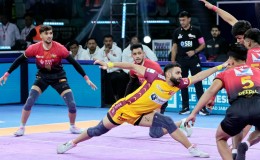 Mumbai: The quarterfinal matches of the AFC Women’s Asian Cup India 2022™ this past week on Sunday saw landmark moments in football in India with the VAR technology being used for the first time in the country. It was before the start of the tournament that the announcement was made that the AFC Women’s Asian Cup India 2022™ will see the use of the VAR from the knockout games.
Mumbai: The quarterfinal matches of the AFC Women’s Asian Cup India 2022™ this past week on Sunday saw landmark moments in football in India with the VAR technology being used for the first time in the country. It was before the start of the tournament that the announcement was made that the AFC Women’s Asian Cup India 2022™ will see the use of the VAR from the knockout games.
The Quarterfinal match between Japan and Thailand, which ended in a 7-0 win for the former, became the first match in India to use the technology. While the VAR was not needed to make any significant decisions in this match played in Navi Mumbai, its presence alone indicated another turning of the page in football history in India.
The VAR became a much more prominent factor in the match that was simultaneously played in Pune. This game's result was perhaps the biggest upset in the competition thus far as Korea Republic defeated pre-tournament favourites, Australia by 1-0. In the first half itself, a VAR check resulted in Korea Republic receiving a penalty. But, Cho So-hyun could not convert from the spot.
There was another significant penalty check in the second half when Steph Catley appeared to have been pushed inside the box, but the VAR, this time around, did not signal for a penalty. Soon after the decision, South Korea's Ji So-yun scored the winning goal in the 87th minute to take her side into the final four.
As football in India is adapting to technological advancements, the use of VAR at the AFC Women's Asian Cup 2022™ has already shown the impact it can have. With the tournament reaching the business end, the VAR can further shape up the remainder of the tournament in new ways and signal for a new era in Indian football.
How is VAR being implemented
At the AFC Women’s Asian Cup India 2022™, six dedicated video match officials have been given access to seven different live camera feeds to inspect all the live action on the field. VAR can review four categories of decisions - Goal/no goal, Penalty/no penalty, Direct red card, and Mistaken identity in awarding a red or yellow card.
The VAR match official and the on-field referee will work together to make the aforementioned category of decisions. A review of decision can only be initiated by either of the two personnel and not by any player. The VAR official can ask an on-field referee to overturn their decision.
At the same time, the on-field referee may also choose to conduct an On-Field Review (OFR) by halting the game and reviewing footage from the screen. At all times, the on-field referee can ignore the advice from the VAR.










